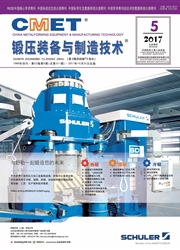

 中文摘要:
中文摘要:
Cold orbital forging is an advanced spur bevel gear forming technology. Generally, the spur bevel gear in the cold orbital forging process is formed by two steps: the preforming step and the final step. Due to the great importance of the final step to gear forming and its complication with interactive factors, this work aims at examining the influence of key factors on the final step in cold orbital forging of a spur bevel gear. Using the finite element(FE) method and control variate method, the influence rules of four key factors, rotation velocity of the upper tool, n, feeding velocity of the lower tool, v, tilted angle of the upper tool, γ, friction factor between the tools and the billet, m, on the geometry and the deformation inhomogeneity of the cold orbital forged gear are thoroughly clarified. The research results show that the flash becomes more homogeneous with increasing v, increasing m, decreasing n or decreasing γ. And the deformation of the gear becomes more homogeneous with increasing v, decreasing n or decreasing γ. Finally, a corresponding experiment is conducted, which verifies the accuracy of FE simulation conclusions.
 英文摘要:
英文摘要:
Cold orbital forging is an advanced spur bevel gear forming technology. Generally, the spur bevel gear in the cold orbital forging process is formed by two steps: the preforming step and the final step. Due to the great importance of the final step to gear forming and its complication with interactive factors, this work aims at examining the influence of key factors on the final step in cold orbital forging of a spur bevel gear. Using the finite element(FE) method and control variate method, the influence rules of four key factors, rotation velocity of the upper tool, n, feeding velocity of the lower tool, v, tilted angle of the upper tool, γ, friction factor between the tools and the billet, m, on the geometry and the deformation inhomogeneity of the cold orbital forged gear are thoroughly clarified. The research results show that the flash becomes more homogeneous with increasing v, increasing m, decreasing n or decreasing γ. And the deformation of the gear becomes more homogeneous with increasing v, decreasing n or decreasing γ. Finally, a corresponding experiment is conducted, which verifies the accuracy of FE simulation conclusions.
 同期刊论文项目
同期刊论文项目
 同项目期刊论文
同项目期刊论文
 Distribution of Microstructure and Vickers Hardness in Spur Bevel Gear Formed by Cold Rotary Forging
Distribution of Microstructure and Vickers Hardness in Spur Bevel Gear Formed by Cold Rotary Forging 期刊信息
期刊信息
